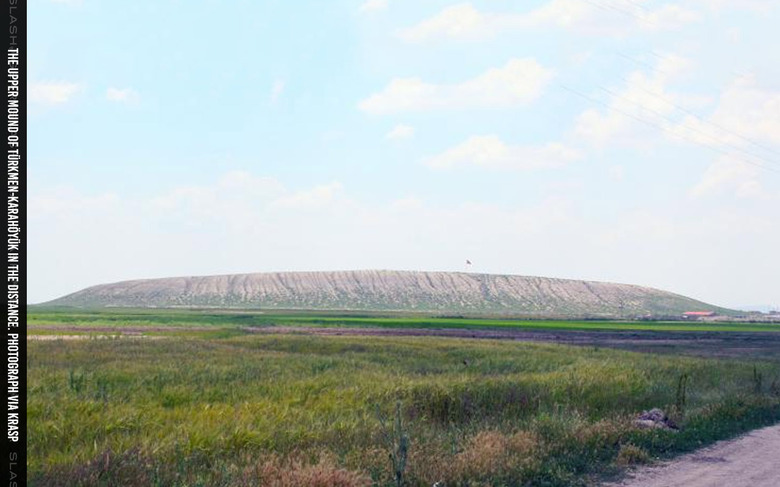Farmer Finds Stone, Reveals Lost King-Toppling Society
A slab of stone the size of a small child was discovered in southern Turkey with clues pointing to a lost civilization. "My colleague Michele Massa and I rushed straight there, and we could see it still sticking out of the water, so we jumped right down into the canal—up to our waists wading around," said Asst. Prof. James Osborne of the Oriental Institute. "Right away, it was clear it was ancient."
Above you'll see a photo captured by Suay Erkuşöz, showing what they now call "The moment of discovery of the TKH 1 inscription." The man in the photo is Prof. Osbourne, quoted above, posing with the stone as it was discovered. "According to the account of a local farmer, he discovered the inscription in the spoil heap of canal fill while quarrying the fill for mudbrick manufacture," wrote Christoph Bachhuber.* The discovered stone (aka stele) was measured at approximately 95cm × 45cm large.
*Bachhuber of the University of Oxford with Michele Massa and James Osborne are listed on the research report "The KRASP 2019 field season and the discovery of an Iron Age capital at Türkmen-Karahöyük." This report can be found with code DOI: 10.18866/biaa2019.17 in Heritage Turkey 2019, pages 33 and 34.

"We recognized the script it was written in: Luwian, the language used in the Bronze and Iron ages in the area," said Professor Osborne. The language translated to tell of the fall of a kingdom that dates back as far as 1,400 BCE.
The inscription was composed by one "Great King Hartapu", and claimed the defeat of the kingdom Phrygia. Upon the tablet were symbols which translated roughly to: "The storm gods delivered the [opposing] kings to his majesty." Symbols representing Hartapu and Phrygia tie together pieces of history yet unknown to modernity.
Analysis and translation of the stele hieroglyphics were done by Petra Goedegebuure and Theo van den Hout of the University of Chicago. These two experts on Luwain are editors of the Chicago Hittite Dictionary. We'll know more about the contents of the symbology with further reports on the area in the near future.
Türkmen-Karahöyük was likely the location of the capital city run by King Hartapu. The stone's implication is that the kingdom he ruled were successful in conquering that of the nearby kingdom of Muska, otherwise known as Phrygia.

King Midas, but not THAT King Midas
Linguistics analysis of the Luwain carved into the stele suggest that the composition was made in the late-eighth-century BC (800-701 BCE). This would place it in-line with classical historian Eusebius's account of the reign of King Midas. This is not the same King Midas as the Midas who was granted a "golden touch" by Dionysus – but the two were of the same house – both apparently ruling Phrygia from its capital city Gordium.
The King Midas that ruled in the 8th century BC was said to have lost power at the sacking of Gordium. A 2003 report suggested that the city of Gordium was destroyed by fire between 845-800BC – that report was published in Antiquity Vol 77 No 296 June 2003.
Continuing Studies
This find was part of the Türkmen-Karahöyük Intensive Survey Project (TISP), about which you can learn more at the University of Chicago. Stick around as we continue to report on finds from this exciting site! Or just head below for more odd finds of ancient bits – farmers have all the luck!
